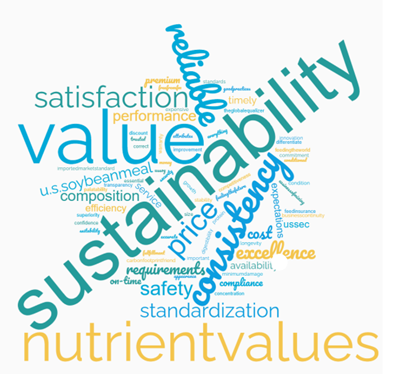
The factors critical to quality in the soy supply chain share common themes of consistency, sustainability and reliability, though the focus shifts for every link.
During Soy Connext in New York City on August 22 and 23, 2023, Thomas D’Alfonso, Ph.D., USSEC director of animal and aquaculture, shared the results of a USSEC survey conducted with soybean growers, buyers, crushers, traders, feed millers and nutritionists. At the same time, a panel of experts representing different pieces of the global supply chain offered their insight on what constitutes quality — and how those factors impact soy purchasing decisions.
According to D’Alfonso, each part of the soy supply chain has a slightly different perspective on what is critical to quality.
- Growers focus on consistency, including keeping soybeans free from foreign material.
- Buyers and crushers mention sustainability, value and reliability most often.
- Sellers and traders talk about standardization and value, including efficiency.
- Feed millers equate on-time delivery with quality, though they also consider nutrient value, consistency and sustainability.
- Nutritionists value consistency and nutrient content.

Together, the responses across the supply chain create an interesting word picture to define quality. The panelists explained how these ideas translate to their businesses, as well as how U.S. Soy measures up to their quality standards.
Why Consistency and Sustainability Work Together
German Bosch, founder and partner at AG Commodities, produces a weekly quality comparison report for soybean exports from the U.S. and Brazil. As a Soy Connext panelist, he explained that harvest practices cause the differences he sees.
Most Brazilian soybeans grow in a tropical environment, and they are harvested during the summer, under high temperature and moisture conditions.
“Those soybeans can contain up to 25% moisture at harvest,” Bosch said. “Drying the soybeans down to 13.5% is hard to do.”
Drying causes damage, and sellers blend soybeans with different levels of damage to reach export standards. It also uses energy, increasing the carbon footprint for their production.
In the U.S., most farmers harvest soybeans in the fall, when conditions allow soybeans to dry naturally in the field. Eliminating the need for drying minimizes soybean damage and fuel use, leading to a more homogeneous product with a lower carbon footprint.
“China buys soybeans from the U.S. and Argentina to store,” he added. “They will even pay a bit more because these soybeans store better.”
In addition to moisture content and damage, his team monitors protein and oil content, as well as the stability and reliability of delivery. He said U.S. Soy compares favorably on many of these factors, though he believes more detailed composition analysis should be done.
Processing Value
The lower moisture content and damage are reasons Soy Connext panelist Tahmina Mostafa, director, Meghna Group of Industries in Bangladesh, imports 300 to 400 metric tons of U.S. Soy each year. Meghna Group crushes soybeans and produces a wide variety of products they sell domestically and abroad. Her team wants value for the money they spend on raw materials.
“Quality and consistency support profitability,” she said. “With U.S. Soy, we have less waste. It costs more, but the quality is higher, so we are willing to pay more.”
She noted that the consistent size and color of U.S. Soy is better for processing, though freight costs from the U.S. to Bangladesh are challenging.
Meghna Group regularly reports on carbon footprint, so sustainability matters, as well. Mostafa considers the U.S. Soy Sustainability Assurance Protocol (SSAP) a way to educate her customers on the value of sustainability.
Nutritional Performance
The third member of the Soy Connext panel, Elenita de Manuel, vice chair and senior animal nutritionist for Universal Feed Mill Corporation in the Philippines, shared her personal observations of feeding soybean meal derived from different origins. She has used soybean meal from Argentina, Brazil, China, and the U.S.
“Animal performance is better with U.S. Soy,” she said. “Typically feed rations include safety margins to account for inconsistency in feedstuffs. I don’t use safety margins when I use U.S. soybean meal because it is so consistent.”
She cites physical and chemical qualities, freshness, color, particle size and more as the characteristics she looks at when considering soybean meal quality. She needs quality to allow Universal to be a reliable, consistent source of feed.
According to de Manuel, sustainability is very important for animal feed production. She appreciates the constant improvement she sees from U.S. soybean farmers. That increases her confidence in U.S. Soy as a reliable, sustainable source of protein.
Learn more about the quality U.S. Soy delivers for animal nutrition.

This story was partially funded by U.S. Soy farmers, their checkoff and the soy value chain.
# # #
